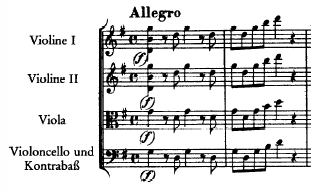Double stop facts for kids
\relative c { \time 4/4 \clef bass \tempo "Allegro" <g e' c'>2 \f \downbow <g d' b'> \downbow <c, g' e' c'>2. \downbow }
</score>
In music, a double stop is a cool trick where you play two notes at the same time on a stringed instrument. Think of instruments like the violin, viola, cello, or double bass. On some instruments, like the Hardanger fiddle, playing two notes at once is very common!
To make a double stop, you use your bow or fingers to play two different strings at the same time. Sometimes, you press down on both strings with your fingers. Other times, one or both strings might be played without pressing them down (these are called "open" strings).
When you play three strings at once, it's called a triple stop. If you play four strings together, it's a quadruple stop. All of these together are known as multiple stopping.
Composers started using multiple stops a lot in the 1600s. Early examples can be found in music by Carlo Farina from 1627 and Biagio Marini from 1629.
Bowing Multiple Strings
It can be tricky to play more than two strings at once with a bow on instruments that have a curved bridge. The bridge is the piece of wood that holds the strings up. Older music books show that composers didn't usually expect musicians to play three notes at the exact same time. Playing four notes at once is almost impossible with a regular bow!
The usual way to play three or four notes together is to play the lower notes very quickly. Then, you let them ring out while you keep bowing the top notes. This creates the sound of a full chord, even though not all notes are bowed at the exact same moment. This is called a broken chord.
However, if the music is very loud (forte), it is possible to play three notes at once. You need to press the bow harder than usual. This technique is often used in powerful parts of music. An example is the solo part at the start of the last movement of Tchaikovsky's violin concerto.
How Notes Are Written
When composers write long chords with three or four notes, they often show which notes should be held. The noteheads for the lower notes might be filled in. This means they are played briefly, like a quick grace note. The noteheads for the notes that should be held longer are left open. You can see this in the beginning of the fourth movement of Beethoven's fifth symphony.
Sometimes, a piece of music might have many notes written for a group of string players in an orchestra. These notes can be played as multiple stops by each musician. Or, the notes can be shared among the players in the section. When the notes are meant to be shared, the word divisi or div. is written above the music. This tells the musicians to divide the notes among themselves.
Plucking Multiple Strings
Double stops are also very common on guitars. You'll hear them a lot in rock, blues, metal, and jazz music. Guitarists can play them by plucking the strings with their fingers (called fingerpicking). They can also use a mix of pick and fingers (called hybrid picking). Sometimes, guitarists can even strum them or use techniques like hammer-ons or pull-offs. The famous guitarist Jimi Hendrix was especially known for using double stops in his music.
When you play three or more notes at the same time on a plucked string instrument (like a guitar), it's usually just called a chord. It's not called a triple stop or quadruple stop in the same way as on bowed instruments.
See also
 In Spanish: Dobles cuerdas para niños
In Spanish: Dobles cuerdas para niños
- Glossary of music terminology

